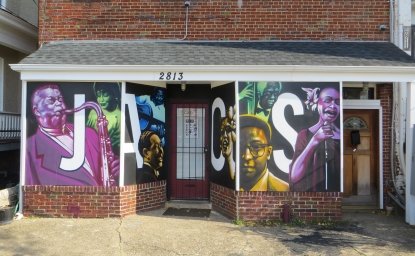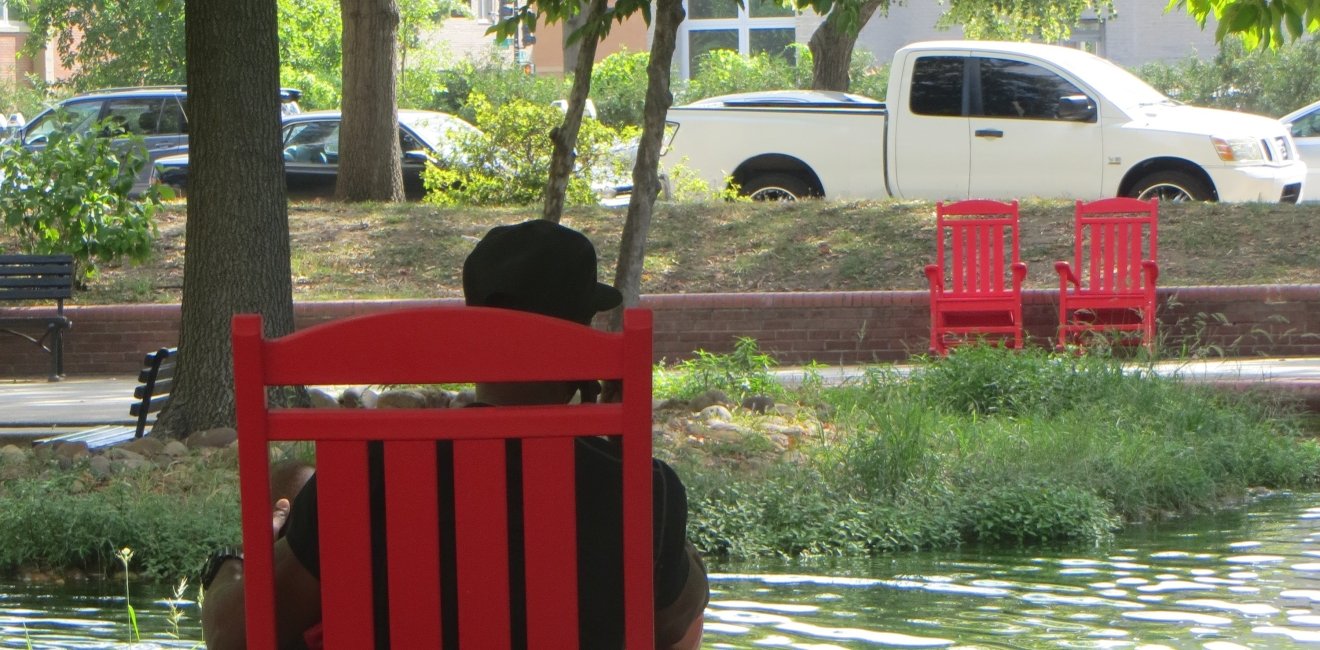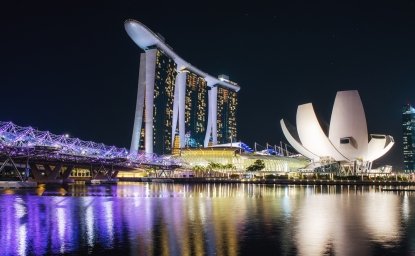Sometimes the smallest of interventions into the life of a city are the most appreciated. This lesson is on display once more with the addition of a dozen or so bright red rocking chairs around the Southwest Duck Pond in Washington, D.C.
The pond was once conceived as a community center for one of the most important 1960s urban renewal projects in the United States: Washington’s Southwest Redevelopment Project. Neither the pond nor the surrounding community quite lived up to such billing. Once proclaimed by prominent architectural critic Wolf Von Eckardt as bringing “suburban wholesomeness with urban stimulation” to downtown Washington, the larger project in fact destroyed many of the social networks that had held the city together. The rockers – which just appeared a few weeks ago -- are a small sign that, after half a century, the city and neighborhood finally are recovering from a colossal planning fiasco.
The redevelopment of Southwest was part of a more extensive slum removal and highway construction effort promoted by planners and their Congressional allies in the hopes of turning Washington into a model demonstration of how planning can solve urban problems. During the 1940s and 1950s, Congress passed a series of laws that unleashed planners to correct previous mistakes in city and regional development. Once empowered, the National Capital Planning Commission aggressively advanced a proposed inner beltway through poor African American neighborhoods adjacent to the central city.
The disastrous Southwest Freeway and accompanying urban renewal project reveal the Commission’s vision for a D.C. remodeled around highways bringing suburbanites in their cars into and out of the city with hardly a poor or African American neighborhood in view. As Jerome S. Paige and Margaret M. Reuss observed, “middle and upper income citizens wanted the slums, which they saw as a reproach to their city, removed. They wanted a clean, sanitary and beautiful environment and they were beguiled by the promise of an increased tax base.” Their efforts to build highways and to remove slums echoed initiatives in nearly every major U.S. city at the time. Washington, however, was different. Without home rule, D.C. was presided over by a Congress that was notoriously unconcerned with the preferences of local residents.
The story is more pernicious than the dreams of misguided planners. By 1952, Washington Post publisher Philip Graham and well-connected wealthy white friends on the Federal City Council had pulled together a half million dollar plan to create a new city alongside the proposed freeway. They enlisted New York construction magnate William Zeckendorf and a young unknown architect, I.M. Pei, to create a new community of apartments, office buildings, and homes from which they would profit as investors. Local residents were no match against such a powerful array of investors, media moguls, and their Congressional sponsors. Only a few skeptical voices would rise above the public relations onslaught promoting the project, as when Eleanor Roosevelt inquired about the fate of the people who once lived in the area after visiting the project in 1959.
The Southwest slums were particularly unseemly and forlorn, a degradation made more poignant by the presence of the Capitol and national monuments and museums in view. The 113-block project zone south of the Mall and north of the Washington Channel was home to 22,539 residents in 1950, nearly 80 percent of whom were African American. Hundreds of buildings had no indoor plumbing; many more were obsolete and below current building code.
Dilapidated though the neighborhood was, few residents wanted to leave. Unfortunately, no one cared to contemplate the answer to Eleanor Roosevelt’s query. The National Capital Planning Commission destroyed 99 percent of the buildings within the project area. As a consequence, almost none of the original residents remained. By 1972, the replacement community had half as many residents, nearly 80 percent of whom were white. They inhabited 5,900 new housing units, of which only 310 were classified as being reserved for low-to-moderate income residents. A densely organized poor African American community had become replaced by an upper middle class, biracial neighborhood. Land use patterns shifted as the population density of the new community was closer to that of inner suburbs than to the city as a whole.
This is when the ducks arrived.
The designers understood that park space represented the sort of suburban amenity their new neighborhood lacked. They set aside a three block long parcel at the corner of Sixth and I Streets SW for shared community space. By the late 1960s, planners, architects, and builders started work on a town center park on the site of what had once been Cow Alley. When it opened in 1972, the park incorporated the modernist design principles of the larger community, including gently curving walks and walls and custom-crafted wooden benches. They added an undulating concrete pond with a picturesque island waiting for migrating ducks to drop in.
None of the public spaces in the development area fared well over time as neighborhoods south of the National Mall generally fell on difficult times. Despite efforts by the National Park Service to maintain the park prior to turning it over to the city in 2007, the very design features meant to attract people drove them away. The fountains necessary for circulating the shallow, cement constrained water often failed, leaving behind foul-smelling algae and breeding grounds for disease-carrying insects. Carefully planted trees often blocked activities in the park from view, intimidating many a passerby. Uncontrolled landscaping provided refuge to drug dealers and other miscreants. The innovative layout of islands and inlets made those who did enter feel trapped in dead ends with no escape. The Park Service gradually replaced the carefully designed furnishings with more serviceable fare. Empty more often than not, even the ducks stopped coming to the park.
By the early 2000s, the city abandoned the notion of preserving the original visionary Southwest Plan and began rebuilding the area yet again. Another “new” Southwest was more thoughtfully renewed with carefully planned in-fill projects and other urban interventions designed to draw fresh life into the area. Ironically, some of these initiatives reconnected the very streets cut off by the earlier round of “regeneration.”
The Duck Pond had remained much loved by many residents despite all of these trepidations. Once firmly in control, the city government began a concerted effort to return the park to its original vision. Plants were trimmed; the pond resealed; the fountains repaired; new benches appeared. By the 2010s, the pond was a much appreciated and visited respite for residents coming and going to a new upscale grocery store nearby. Even the ducks reappeared.
One day in August 2016, red rocking chairs popped up. About a dozen or so were scattered around the benches and on the various little pods and islands, adding charm to an otherwise dismal man-made pond. They formed movable conversation pits just as the heat of high summer cranked up. People came. Some were small groupings hanging out on a gentle summer’s evening; others were loners catching up on their email; still others were grocery shoppers ready for a brief respite before their trek home.
Even if the red rockers do not survive until the autumnal return of the ducks, they already are a success. The smallest of all possible interventions, their impact is huge as they lure new users into the park. Sometimes, small really is beautiful.
Author

Former Wilson Center Vice President for Programs (2014-2017); Director of the Comparative Urban Studies Program/Urban Sustainability Laboratory (1992-2017); Director of the Kennan Institute for Advanced Russian Studies (1989-2012) and Director of the Program on Global Sustainability and Resilience (2012-2014)

Urban Sustainability Laboratory
Since 1991, the Urban Sustainability Laboratory has advanced solutions to urban challenges—such as poverty, exclusion, insecurity, and environmental degradation—by promoting evidence-based research to support sustainable, equitable and peaceful cities. Read more

Explore More in Building Inclusive and Livable Cities
Browse Building Inclusive and Livable Cities
Hometown D.C.: America's Secret Music City

Bringing New York to the Broadway Stage



